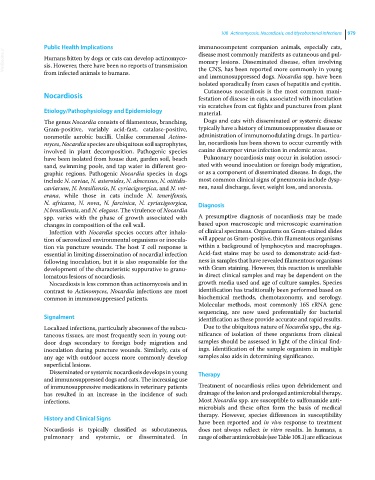Page 1041 - Clinical Small Animal Internal Medicine
P. 1041
108 Actinomycosis, Nocardiosis, and Mycobacterial Infections 979
Public Health Implications immunocompetent companion animals, especially cats,
VetBooks.ir Humans bitten by dogs or cats can develop actinomyco- disease most commonly manifests as cutaneous and pul-
monary lesions. Disseminated disease, often involving
sis. However, there have been no reports of transmission
from infected animals to humans. the CNS, has been reported more commonly in young
and immunosuppressed dogs. Nocardia spp. have been
isolated sporadically from cases of hepatitis and cystitis.
Cutaneous nocardiosis is the most common mani-
Nocardiosis festation of disease in cats, associated with inoculation
via scratches from cat fights and punctures from plant
Etiology/Pathophysiology and Epidemiology material.
The genus Nocardia consists of filamentous, branching, Dogs and cats with disseminated or systemic disease
Gram‐positive, variably acid‐fast, catalase‐positive, typically have a history of immunosuppressive disease or
nonmotile aerobic bacilli. Unlike commensal Actino administration of immunomodulating drugs. In particu-
myces, Nocardia species are ubiquitous soil saprophytes, lar, nocardiosis has been shown to occur currently with
involved in plant decomposition. Pathogenic species canine distemper virus infection in endemic areas.
have been isolated from house dust, garden soil, beach Pulmonary nocardiosis may occur in isolation associ-
sand, swimming pools, and tap water in different geo- ated with wound inoculation or foreign body migration,
graphic regions. Pathogenic Nocardia species in dogs or as a component of disseminated disease. In dogs, the
include N. caviae, N. asteroides, N. abscessus, N. otitidis‐ most common clinical signs of pneumonia include dysp-
caviarum, N. brasiliensis, N. cyriacigeorgica, and N. vet nea, nasal discharge, fever, weight loss, and anorexia.
erana, while those in cats include N. tenerifensis,
N. africana, N. nova, N. farcinica, N. cyriacigeorgica, Diagnosis
N.brasiliensis, and N. elegans. The virulence of Nocardia
spp. varies with the phase of growth associated with A presumptive diagnosis of nocardiosis may be made
changes in composition of the cell wall. based upon macroscopic and microscopic examination
Infection with Nocardia species occurs after inhala- of clinical specimens. Organisms on Gram‐stained slides
tion of aerosolized environmental organisms or inocula- will appear as Gram‐positive, thin filamentous organisms
tion via puncture wounds. The host T cell response is within a background of lymphocytes and macrophages.
essential in limiting dissemination of nocardial infection Acid‐fast stains may be used to demonstrate acid‐fast-
following inoculation, but it is also responsible for the ness in samples that have revealed filamentous organisms
development of the characteristic suppurative to granu- with Gram staining. However, this reaction is unreliable
lomatous lesions of nocardiosis. in direct clinical samples and may be dependent on the
Nocardiosis is less common than actinomycosis and in growth media used and age of culture samples. Species
contrast to Actinomyces, Nocardia infections are most identification has traditionally been performed based on
common in immunosuppressed patients. biochemical methods, chemotaxonomy, and serology.
Molecular methods, most commonly 16S rRNA gene
sequencing, are now used preferentially for bacterial
Signalment identification as these provide accurate and rapid results.
Localized infections, particularly abscesses of the subcu- Due to the ubiquitous nature of Nocardia spp., the sig-
taneous tissues, are most frequently seen in young out- nificance of isolation of these organisms from clinical
door dogs secondary to foreign body migration and samples should be assessed in light of the clinical find-
inoculation during puncture wounds. Similarly, cats of ings. Identification of the sample organism in multiple
any age with outdoor access more commonly develop samples also aids in determining significance.
superficial lesions.
Disseminated or systemic nocardiosis develops in young Therapy
and immunosuppressed dogs and cats. The increasing use
of immunosuppressive medications in veterinary patients Treatment of nocardiosis relies upon debridement and
has resulted in an increase in the incidence of such drainage of the lesion and prolonged antimicrobial therapy.
infections. Most Nocardia spp. are susceptible to sulfonamide anti-
microbials and these often form the basis of medical
therapy. However, species differences in susceptibility
History and Clinical Signs
have been reported and in vivo response to treatment
Nocardiosis is typically classified as subcutaneous, does not always reflect in vitro results. In humans, a
pulmonary and systemic, or disseminated. In range of other antimicrobials (see Table 108.1) are efficacious

